CS GO: A classic of eSports
It is a classic, familiar from computer clubs: match participants are divided into teams of terrorists and special forces, and then fight against each other on the map, where there are rooms and open spaces, corridors with shelters, and workarounds. The story of Counter-Strike began in the late 90's, when two enthusiasts decided to create a modification about gangsters and policemen for the popular action movie Half-Life. Since then, the game came out in several versions, from the early 1.6 to the current Global Offensive, eventually becoming the standard of online shooters with a first-person perspective and at the same time a cyber sports discipline. Let's find out why it appeals to the public today.
What's the game about?
Shootouts are available immediately after installing the game - no one makes you warm up on the training areas, and all the subtleties are learned in practice. There is nothing to be afraid of, because the algorithm selects allies and opponents so that everyone has the same chances. And even a newcomer, first appeared on the battlefield, gets an opportunity to look at others and show yourself. No one prevents you from inviting your friends along as well - the free Steam version of Global Offensive displays all the friends who are available for the match in the main menu on the left.
Counter-Strike traditionally offers two formats of battles: laying bombs and freeing hostages. In the first, the terrorists must activate an explosive at either of two points, and the SWAT team must disarm the device while the timer is ticking. In the second, the bad guys defend a building with civilians trapped inside, while the cops storm the fortification and take out as many hostages as they can rescue. Both types of battles can also be won by routinely eliminating enemies: if all enemies are killed, the victory will be counted even without bombs and prisoners. Each match is divided into 15 rounds, that is, a team must have 8 victories to win the championship. And squads are free to switch roles: for example, starting as terrorists, after the middle of the game you switch to the side of the special forces, and vice versa.
Counter-Strike traditionally offers two formats of battles: laying bombs and freeing hostages. In the first, the terrorists must activate an explosive at either of two points, and the SWAT team must disarm the device while the timer is ticking. In the second, the bad guys defend a building with civilians trapped inside, while the cops storm the fortification and take out as many hostages as they can rescue. Both types of battles can also be won by routinely eliminating enemies: if all enemies are killed, the victory will be counted even without bombs and prisoners. Each match is divided into 15 rounds, that is, a team must have 8 victories to win the championship. And squads are free to switch roles: for example, starting as terrorists, after the middle of the game you switch to the side of the special forces, and vice versa.
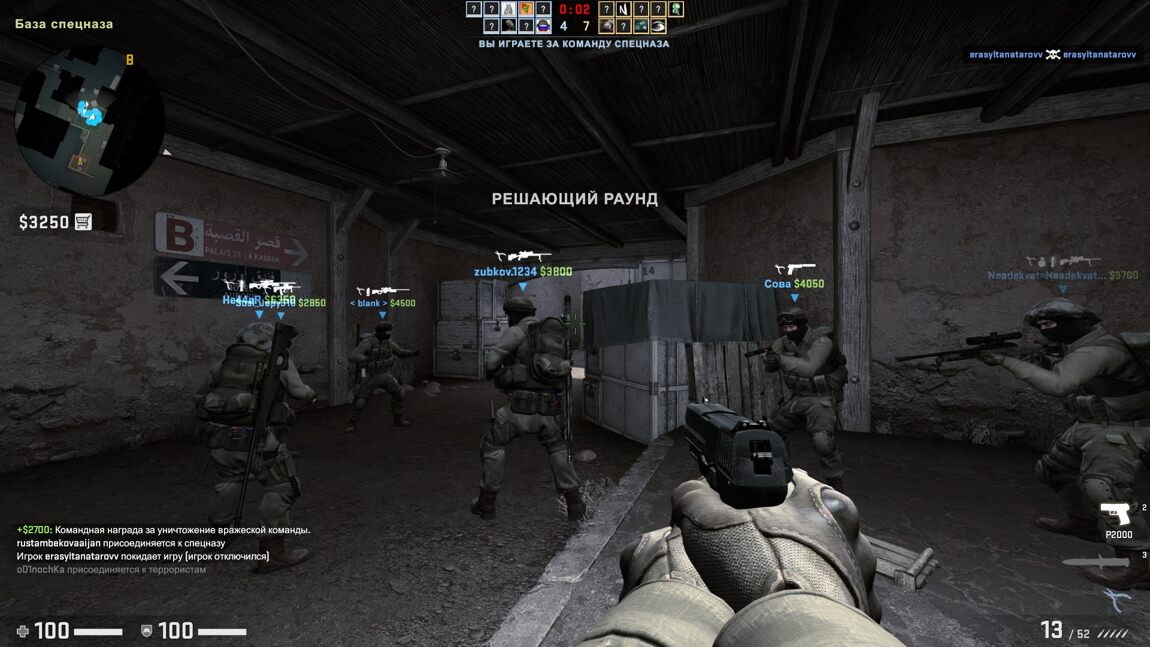
Participants in the match are divided into two teams of ten. And for all kept statistics, by which you can understand who in the squad is beneficial and who is fooling around - it displays the number of murders with wounds, support comrades and the total score on points. An example of unsportsmanlike conduct is quitting the party before the end of the round - in this case you not only let your teammates down, but also get banned for half an hour. Repeated violation leads to a one-hour ban from participation in matches with other users, and the third is fraught with a ban for 24 hours. Members of the team themselves can also expose unreliable gamers, for which Counter-Strike provides voting - through it expel cheaters that use cheating programs to win, rude people and other shady characters. Even if you fail to cope with something and make inexperienced mistakes, it is not a reason to take offense or run to the lobby. In such situations, it is better to learn rather than freak out: having fallen in battle, it is enough to switch on "Observation Mode" and watch the actions of the survivors to gain useful experience.
Bots - characters controlled by artificial intelligence - are also helpful. If there is no internet or a fight against live opponents, you can run a single mode with computer dummies. And if there is a shortage of participants in the normal party game adds bots and in teams. Notice the difference between them and real people is difficult for a beginner, because they act quite correctly and are a danger at any distance. Additionally to improve accuracy helps "Instruction" - the map for those who want to stretch before an important match or just try a new mouse. In fact, it's an ordinary shooting gallery, where you have to run from one stand to another, shooting targets and dummies at the same time.
In addition to the usual fights, competitive ones are available in Global Offensive. Here all the same hostages and bombs, but there is a number of features. Rounds in the match are more - as much as 30, and the change of roles occurs automatically after 15 rounds. If the score of both teams is 15-15, a draw is declared. Competitive mode, in contrast to the usual, brings rewards for victories, allows you to grow in levels and get new ranks, watch replays of the firefights and shoot at their own. That is, a cheater or bully who wants to ruin the game for others, immediately becomes a problem for the whole team - and he is expelled faster than from the usual match. Also available ranked battles, allowing you to acquire ranks and move up the global list of leaders. But to participate in these battles you must have a Prime account - it is bought for money, and to achieve it for free since June 2021, alas, it is impossible. But in the shootouts of premium account owners a lot less cheating and clowning, because everyone values their status and take the game seriously - in a sporting way.
Bots - characters controlled by artificial intelligence - are also helpful. If there is no internet or a fight against live opponents, you can run a single mode with computer dummies. And if there is a shortage of participants in the normal party game adds bots and in teams. Notice the difference between them and real people is difficult for a beginner, because they act quite correctly and are a danger at any distance. Additionally to improve accuracy helps "Instruction" - the map for those who want to stretch before an important match or just try a new mouse. In fact, it's an ordinary shooting gallery, where you have to run from one stand to another, shooting targets and dummies at the same time.
In addition to the usual fights, competitive ones are available in Global Offensive. Here all the same hostages and bombs, but there is a number of features. Rounds in the match are more - as much as 30, and the change of roles occurs automatically after 15 rounds. If the score of both teams is 15-15, a draw is declared. Competitive mode, in contrast to the usual, brings rewards for victories, allows you to grow in levels and get new ranks, watch replays of the firefights and shoot at their own. That is, a cheater or bully who wants to ruin the game for others, immediately becomes a problem for the whole team - and he is expelled faster than from the usual match. Also available ranked battles, allowing you to acquire ranks and move up the global list of leaders. But to participate in these battles you must have a Prime account - it is bought for money, and to achieve it for free since June 2021, alas, it is impossible. But in the shootouts of premium account owners a lot less cheating and clowning, because everyone values their status and take the game seriously - in a sporting way.

Counter-Strike shooter has become a cyber sport discipline for a reason. The balance in it is perfect, it is impossible to buy a victory or any reinforcement, and success depends largely on the skill of the gamer and coordinated work of the whole team. In played squad roles are usually distributed in advance - at the start of each round, when soldiers buy equipment. One immediately stomps into an ambush with a sniper rifle, the other throws a smoke grenade to cover the offensive comrades, the terrorists have the most experienced trust carry and lay explosives, special forces masterful gunner covers the evacuation of hostages. To be effective you must not only have good reaction and a keen eye, but also know by heart every corner of the map - understand what "Rush on B", "Sniper on the Carpets", "Zamest on the Banana", "Climbing out of the Tommy" when these phrases sound in the headphones. Voice and text chats play a huge role in the match, because without communication you can not coordinate the actions of the squad.
CS players in general use a lot of terms that can confuse the uninitiated person. Here are some of them: "plaint" - point of laying bombs, "pic" - checking the area by looking out from behind a shelter, "byte" - provocation of the enemy to certain actions (eg, to throw a grenade or move from one point to another), "streif" - running sideways, making you a difficult target and allows you to shoot on the fly, "aim" - the ability to quickly aim with the mouse, "prefire", aka "pref" - is the shooting from cover to the place where the enemy is supposed to be, i.e. the anticipatory fire. Of course, these are not all the words from the lexicon of shooter fans. There are also terms related to the features of maps, weapons and match conditions, which we will talk about next.
CS players in general use a lot of terms that can confuse the uninitiated person. Here are some of them: "plaint" - point of laying bombs, "pic" - checking the area by looking out from behind a shelter, "byte" - provocation of the enemy to certain actions (eg, to throw a grenade or move from one point to another), "streif" - running sideways, making you a difficult target and allows you to shoot on the fly, "aim" - the ability to quickly aim with the mouse, "prefire", aka "pref" - is the shooting from cover to the place where the enemy is supposed to be, i.e. the anticipatory fire. Of course, these are not all the words from the lexicon of shooter fans. There are also terms related to the features of maps, weapons and match conditions, which we will talk about next.
What other modes are represented here?
Battles in normal and competitive modes of Global Offensive are not the only ones - you can have fun in other formats here as well. So that no one is confused by the choice of items in the start menu of the game, we should tell you more about them:
- "Wargames" is a whole set of modes that have been added to the game at the request of users. The composition of the section changes from time to time, but some of the contests remain unchanged. Among the constants is "Arms Race", where you have only one round with the possibility to be revived after death, and the struggle is carried out until one of the teams opens a golden knife and does not commit a murder with it. There's also "Destroy an Object", which combines the rules of a bomb-laying match with an "Arms Race", and "Flight Snipers", a shootout on a map with reduced gravity that allows you to soar and maneuver in flight.
- "Fight to the death" - familiar from most multiplayer shooters: 10 minutes the participants of the opposing teams shoot each other, revive and go into battle again, until at the end of the battle to determine the winner with the most points. Funnily enough, even killing chickens wandering around the location earns points - for every dead bird you get one point.

- "Partners" is a mode that replicates the scenario of planting and demining a bomb. Only it involves only four people, two terrorists and a couple of special forces. The match lasts 16 rounds of a minute and a half each and is held on reduced versions of the maps, and the point for laying the explosives on them only one.
- "Forbidden Zone" is a competition under the rules of "Battle Royale", which, of course, no modern online shooter can do without. Here and Counter-Strike remains in the trend, offering to fight to the last survivor on a spacious map. In this mode, you can act alone (then the battlefield will be 16 players) or with a partner, confronting eight more of the same duo. If one of your comrades dies, he gets a chance to return to the battlefield while the second member of the duo is alive. "Forbidden Zone" is set up in much the same way as other members of the genre: you land in an area, collect weapons, armor, and supplies, and then try to eliminate all enemies in a safe area that shrinks in size over time. But there are nuances. For example, the map here is divided into hexagonal sectors - one for each trooper.
- There are also "Operations", which can be regarded as additions. They usually include modes and maps, and tasks with rewards. All operations are paid, but it is a way to try something new within Counter-Strike: Global Offensive - some maps and modes (for example, "Arms Race") got to the main core of the game from here. Nevertheless, each operation lasts for a certain amount of time and then ends. Say, "Broken Fang", where the fan-created world of Frostbite was presented, started in December 2020 and ended on May 4, 2021.
Weapons and other equipment
Counter-Strike combines shooting and economics in a very original way. On the one hand, the steeper the gun, the higher the chance to deal with your opponent, but on the other hand, you have to earn money for a steep gun. Each round in the match starts with the purchase of weapons and equipment. You get knives and the simplest guns for free, but then everything depends on the successful completion of tasks: if your squad eliminates enemies, terrorists manage to explode bombs and special forces rescue hostages, all this is added to the "minimum rate" and meticulously counted in the payment of fees at the start of the next round. The weaker team usually has to save money, while the more agile gamers are always on the financial side of the arsenal. Often it is necessary to spend a round with a bare hand to then buy a full - in CS fan slang, the first is called "full eco" and the second "full buy. In addition, not all players are not equally effective: it happens that a person with a lot of virtual bucks to buy equipment for a comrade with empty pockets.
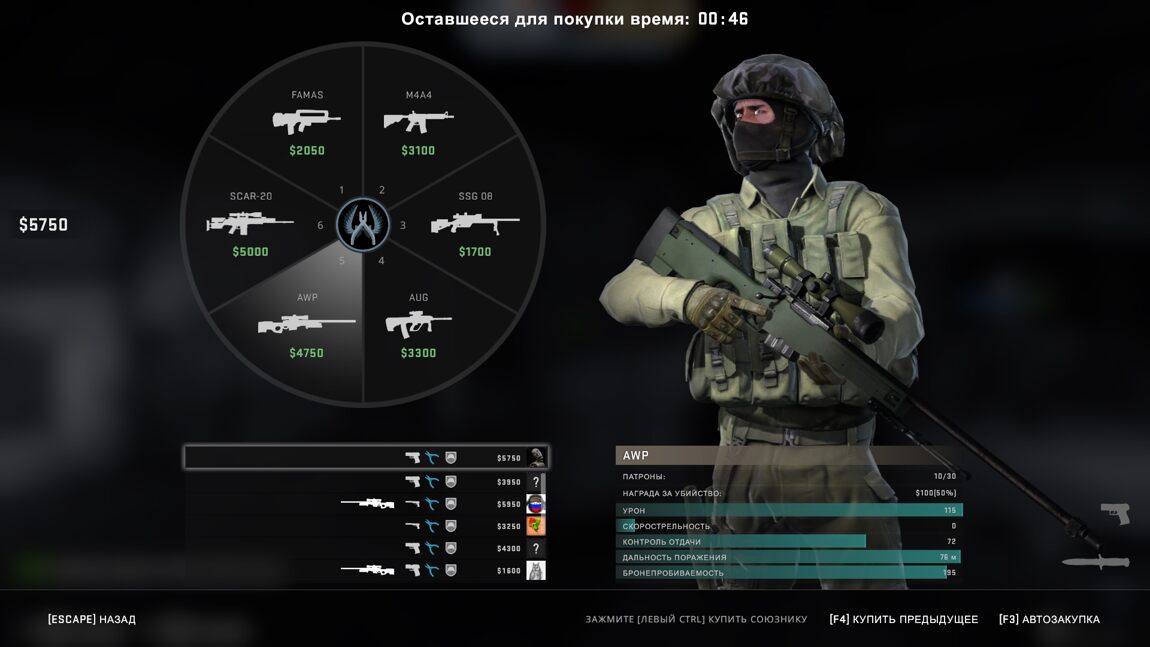
In other words, the choice of guns depends not on the round number, but on the earnings of the whole team and its individual members. The game encourages you to think and plan ahead, not just shoot like a real sharpshooter. Special arsenals of terrorists and special forces add interest: although some guns are equally available to both, there are unique models. In particular, to get a pair of Beretta pistols to shoot with two hands ("the Macedonian way"), automatic AK-47, Galil and SG553 can only bad guys, and the forces of law and order in stock is the good old "Emka" with a silencer, submachine gun MP9, assault rifles AUG and FAMAS. The only way to test the enemy team's gun is by picking it up from the body of a dead enemy.
However there are weapons that have a high killing power and are available to both sides of the conflict. Among these guns are Desert Eagle, aka "Deagle", submachine guns MP5 and P90 (the latter is usually called "Cock"), machine gun M249 ("Chechnya") and sniper rifles Scout and AWP. The latter is the most expensive and dangerous weapon in the game, capable of killing with a single bullet. Not without reason the AWP is nicknamed "Elephant Boy". But to use this rifle you need experience and quick reaction - you must shoot almost at the very moment when the enemy's figure appears in the optical sight. And since not everyone is capable of such tricks, the "Elephant Boy" is usually given to the most accurate member of the team. The gun costs a lot of money, so it is cherished: if the sniper is killed, the comrades try to pick up the rifle and take it with them to the next round.
Often the losing squad resorts to the tactic of "Safe", when the last member of the team hides with a valuable gun in a secluded corner of the map. Since the round lasts for almost two minutes, the enemies don't have much time to find it - and more often than not the trick works. On the other hand, members of a squad that is clearly on its way to victory can throw expensive guns off the map, so that the losers don't get a free arsenal for the next round. And the losers, of course, will have no money to buy better weapons.
However there are weapons that have a high killing power and are available to both sides of the conflict. Among these guns are Desert Eagle, aka "Deagle", submachine guns MP5 and P90 (the latter is usually called "Cock"), machine gun M249 ("Chechnya") and sniper rifles Scout and AWP. The latter is the most expensive and dangerous weapon in the game, capable of killing with a single bullet. Not without reason the AWP is nicknamed "Elephant Boy". But to use this rifle you need experience and quick reaction - you must shoot almost at the very moment when the enemy's figure appears in the optical sight. And since not everyone is capable of such tricks, the "Elephant Boy" is usually given to the most accurate member of the team. The gun costs a lot of money, so it is cherished: if the sniper is killed, the comrades try to pick up the rifle and take it with them to the next round.
Often the losing squad resorts to the tactic of "Safe", when the last member of the team hides with a valuable gun in a secluded corner of the map. Since the round lasts for almost two minutes, the enemies don't have much time to find it - and more often than not the trick works. On the other hand, members of a squad that is clearly on its way to victory can throw expensive guns off the map, so that the losers don't get a free arsenal for the next round. And the losers, of course, will have no money to buy better weapons.
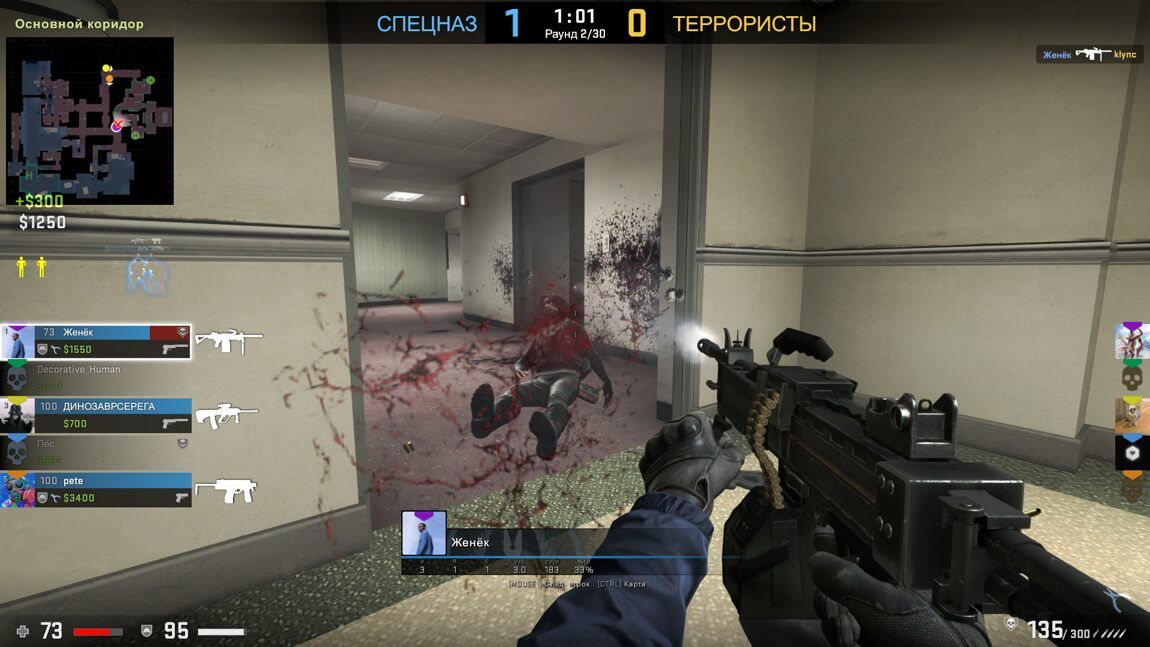
If firearms in the game - the cornerstone of the economy, then the rest of the equipment is easier: you either buy armor and consumables, or not. Sometimes you can get by with just one gun at a reasonable price - the same "Rooster", for example. But a more or less balanced purchase will need a protective vest and a couple of grenades in addition. The former will save you under fire, and the latter will allow you to inflict damage on several enemies at once and support your comrades. Grenades and Molotov cocktails are rarely killed in CS, but they are still useful. Smoke cannon disguises the attack and also allows you to lay or clear the bomb, stun grenade (aka "Blind" - emphasis on the first syllable) is indispensable during assault, and the bottle with a flammable mixture creates a barrier between you and the enemy during retreat or a fight in a narrow corridor. The Special Forces are saved by the EOD kit (Defuse), bought at the beginning of the round, which speeds up demining by half when the line between victory and defeat is separated by seconds. Unlike most shooters, Counter-Strike: Global Offensive has almost no medical supplies - this consumable is only available in the Forbidden Zone.
Maps and basic tactics
The game's charm rests on three factors. The first is shooting weapons of all sorts, the second is the economy, thanks to which even the most dashing shooter runs the risk of a round with a knife and a gun, and the third is the locations where the battles unfold. Since the early version of the shooter, maps in Counter-Strike are no less important than the gun in your hand and the ability to use it. It is always useful to know the direct and detour routes to the target, the secluded places for ambushes, the best shelters and points where it is more expensive to hide. The names and locations of certain areas of the map are memorized by the players so that no one gave weakness at the crucial moment. When allies tell you that the enemy has left one position, you must immediately figure out where the enemies can go. Just as quickly you should think when reports of an attack from a certain direction. These moments sometimes decide the outcome of the match.
Global Offensive has dozens of maps, but for convenience they are sorted by mode. There are special sets of terrain for "Demining", "Freeing Hostages", "Arms Race", "Partners" and "Forbidden Zone", and the competition for laying and disarming the bomb was awarded special attention. There's a "Delta" group with the most popular locations, as well as a "Sigma" group with maps invented by users, or lacking the balance needed for tournaments. In addition, the game offers grouping by category: "Advanced maps" include time-tested variants used in competitive mode, while "Reserve maps" are usually new locations invented by developers or fans.
Global Offensive has dozens of maps, but for convenience they are sorted by mode. There are special sets of terrain for "Demining", "Freeing Hostages", "Arms Race", "Partners" and "Forbidden Zone", and the competition for laying and disarming the bomb was awarded special attention. There's a "Delta" group with the most popular locations, as well as a "Sigma" group with maps invented by users, or lacking the balance needed for tournaments. In addition, the game offers grouping by category: "Advanced maps" include time-tested variants used in competitive mode, while "Reserve maps" are usually new locations invented by developers or fans.
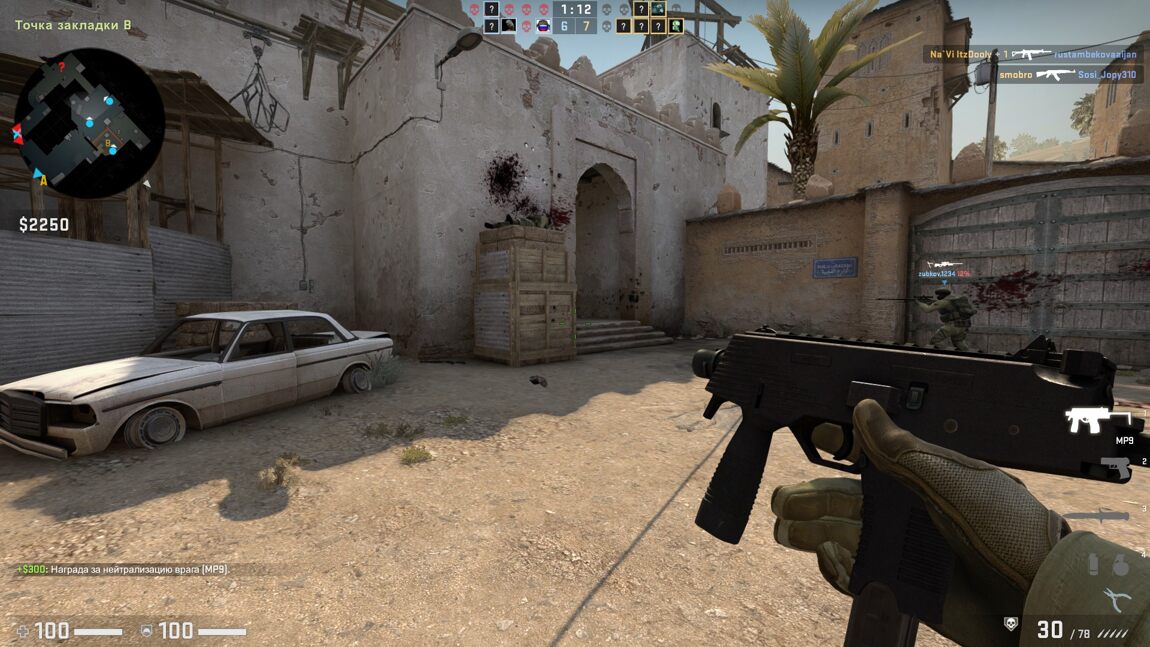
The only card that makes up a category by itself is Dust II. This is a classic level that has existed in Counter-Strike since 2001. The terrain is created for the mode "Demining" and is inspired by the color of the Middle East: sand-filled streetsides, squat buildings with windows without glass, palm trees, burnt cars - in short, the town of those where they wear beards and shoot with "kalashov". The map traditionally contains two bombing points - A and B, only the paths to them are different. From the terrorists' base to B you can pass with short-to-medium range fights, while the road to A is through the starting location of the special forces or along the longest street ("Long" aka "Length"), where the snipers usually do their work. It would seem such a minor difference, but how many tactics associated with it! Active actions begin in the first seconds of the round. Here's an example: if the terrorists bought a machine gun or sniper rifle, they immediately shoot through the wooden gate leading to the center ("Mead") level, where the Special Forces run through to protect B. And they, in turn, close the gap between the gate flaps with a smoke grenade. The bad guys need stun grenades and a breakthrough through the building with a spiral staircase ("Dimka") to get to the same point quickly.
Of course, there are quite a few notable maps besides Dust II. Let's talk in general terms about the most popular ones, where matches are most often played:
Of course, there are quite a few notable maps besides Dust II. Let's talk in general terms about the most popular ones, where matches are most often played:
- Italy - the name speaks for itself: the map abounds with narrow streets and Mediterranean-style houses, where, according to legend, French special forces are fighting separatists. Unlike Dust II, "Italy" is designed to free hostages. The peculiarity of the terrain is that there are few open areas - the only exception is the area, which is called among gamers "Bazaar". Therefore, even a shotgun is in use here, bought on other maps from the lack of money, and many issues are solved by grenades. For example, the commandos use the following trick: throw a smoke grenade into the room with the hostage and take him out, taking advantage of the confusion.
- Mirage is a map designed in the Middle Eastern style and created for the "Demining" mode. It is just as impressive as Dust II in design and scale, but boasts secluded areas and sniper positions where you can wait long periods of time for your prey ("camping") or surprise your enemy at close range. This is where the famous "Carpets" and Undercover (Under Carpets) are located, from where playnt A is shot through. So good team chemistry is needed to defend and storm both places under explosives.
- Inferno is an urban demining map, designed in an Italian entourage. It is rich in architectural details and shelters, and on top of that is known for making captured plein airs extremely hard to beat back. The long, curved street, popularly nicknamed "Banana", allows you to control point B, alarm your opponents on A, and effectively collect tactical data, so it's well known: Whoever owns "Banana" owns the situation. "Inferno" is perfectly balanced - you can often see it in Counter-Strike tournaments.
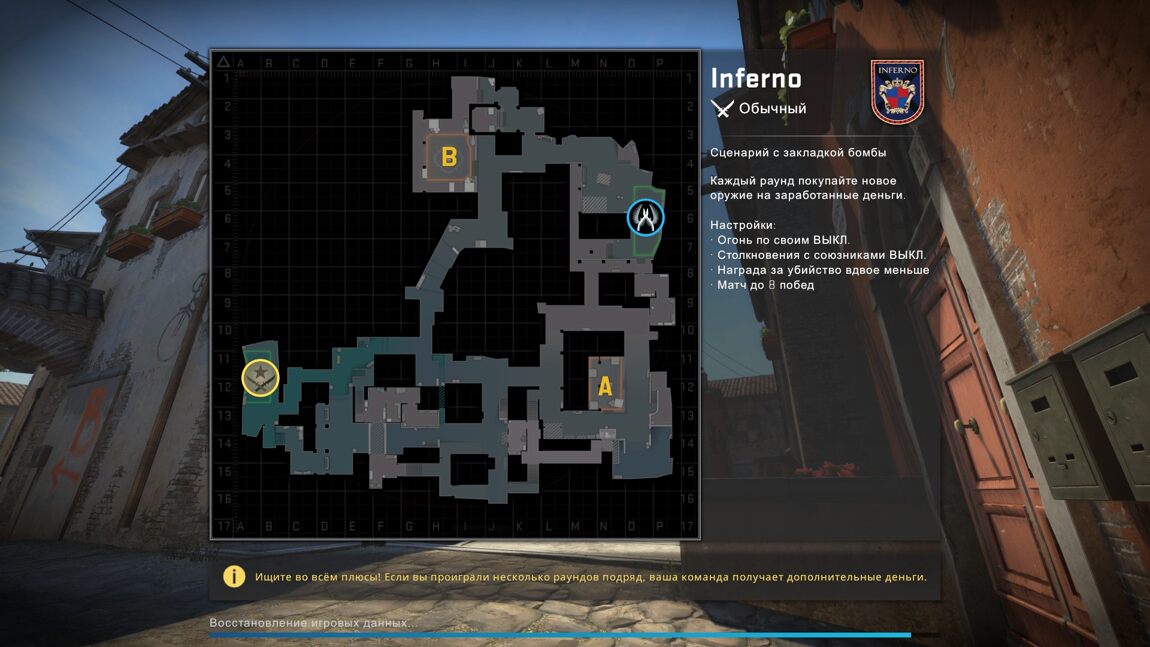
- Office, according to avid players, can be considered the benchmark map with hostages. It stands out from the rest: if most locations are sunny and southern, then here it is winter and there are snowdrifts. There are almost no street battles, and the main action unfolds inside a large building - in fact, the office. The abundance of rooms and corridors somewhat reduces the usefulness of the assault and sniper rifles, but a couple of positions for aiming through the optics still have - this window near the base of the special forces and "Long" inside the house. The strategies of both teams depend on the location of the hostages, which can change from round to round.
- Train is a map that takes the action to Russia, which is rare for Counter-Strike. Terrorists and special forces are fighting in the train depot - with a lot of cars, tunnels, containers and old brick walls. One team must plant the bomb, and the other to disarm it, but to do all this is not so easy because of the objects blocking the view. Therefore, the requirements for the competent use of grenades and Molotov cocktails are very high - before the match it is better to watch some educational video on YouTube and try to repeat the seen techniques yourself. Newcomer to the map has a hard time, because the situation such as "killed in the middle of nowhere" is the order of the day.
- Nuke offers to fight at the American nuclear power plant Cedar Creek. The map is dedicated to defusing explosives and is an industrial style complex with a large area around it ("Outside"). If you look at the area from above, it may appear that playtes A and B are adjacent, but in fact they are placed at different levels vertically. A special feature of the map is that the battlefield is divided into floors, and transitions between them are possible by both stairs and ventilation (by "Screw"), which opens up room for tactical tricks and camping.
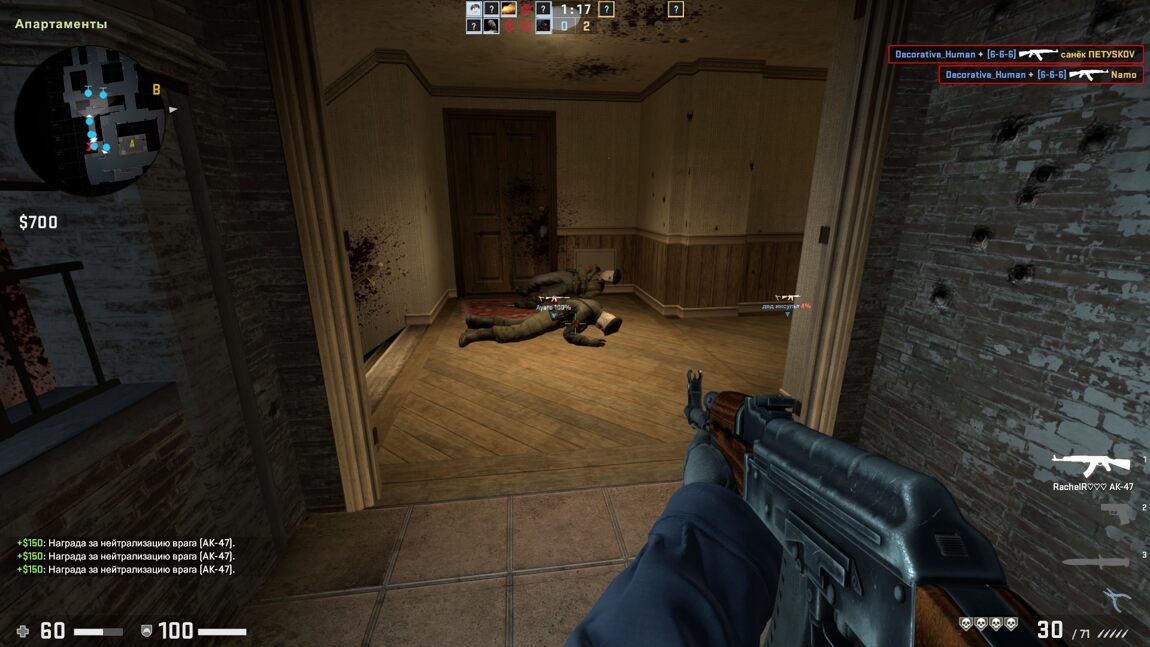
The basis of tactics in the shooter, strange as it may sound, are the headphones and the microphone you use. The former, depending on their quality, allow you to calculate the enemy's position and the type of their weapons by sound, and at the same time use the data coming from your allies. A microphone, on the other hand, allows you to share this data. And don't expect literary language in the chat - only slang sounds here. After all, it is necessary to convey to your comrades any information, from the observed enemy to the location of his own death, briefly and clearly. Even about the remnants of health in the wounded enemy should be reported: for example, the phrase "glazed in Temka" means that the enemy in the room overlooking the door on the Dust II map B, has very little health left. To avoid cluttering up the airwaves, it's easier to say it in jargon than to explain everything in more familiar terms.
The second nuance is shooting. The main rule, which should be taken as a pencil, is that the shot falls accurately in the sight's crosshair only if you are immovable. And after all the weapons have recoil, and the characters in the game are subject to a slight inertia after stopping. In order to reduce it experienced gamers use the so called "reverse-strafing". Let's say you are moving sideways to the right, holding down the D key - for a precise shot you should not slow down by releasing this button, but release D and press A for a moment, which will lead to quick dampening of inertia and allow you to put a bullet in the target at once.
It is useful to know that the speed of movement is affected by the weight of the gun in his hands. Fighters run fastest if they are holding a knife. There is also a trick with crouching shooting from behind a cover: in this position the camera is not deflected to any side for you, at that your character's head, if you look at it from the side, goes a bit to the right and becomes hidden from the enemy. So there is no risk of getting shot in the head in such a situation. Some beginners also find it difficult to adjust the rear sight correctly when waiting in ambush. The crosshair should be at the opponent's head level and it's also necessary to observe the reaction zone. It's almost unreal to hit the figure at the very moment when it appears in the field of view. Only cyber-athletes are able to do such tricks. That's why you should aim a little aside from the door or the corner from where the enemy should run out in order to give yourself a fraction of a second to pull the trigger.
The second nuance is shooting. The main rule, which should be taken as a pencil, is that the shot falls accurately in the sight's crosshair only if you are immovable. And after all the weapons have recoil, and the characters in the game are subject to a slight inertia after stopping. In order to reduce it experienced gamers use the so called "reverse-strafing". Let's say you are moving sideways to the right, holding down the D key - for a precise shot you should not slow down by releasing this button, but release D and press A for a moment, which will lead to quick dampening of inertia and allow you to put a bullet in the target at once.
It is useful to know that the speed of movement is affected by the weight of the gun in his hands. Fighters run fastest if they are holding a knife. There is also a trick with crouching shooting from behind a cover: in this position the camera is not deflected to any side for you, at that your character's head, if you look at it from the side, goes a bit to the right and becomes hidden from the enemy. So there is no risk of getting shot in the head in such a situation. Some beginners also find it difficult to adjust the rear sight correctly when waiting in ambush. The crosshair should be at the opponent's head level and it's also necessary to observe the reaction zone. It's almost unreal to hit the figure at the very moment when it appears in the field of view. Only cyber-athletes are able to do such tricks. That's why you should aim a little aside from the door or the corner from where the enemy should run out in order to give yourself a fraction of a second to pull the trigger.
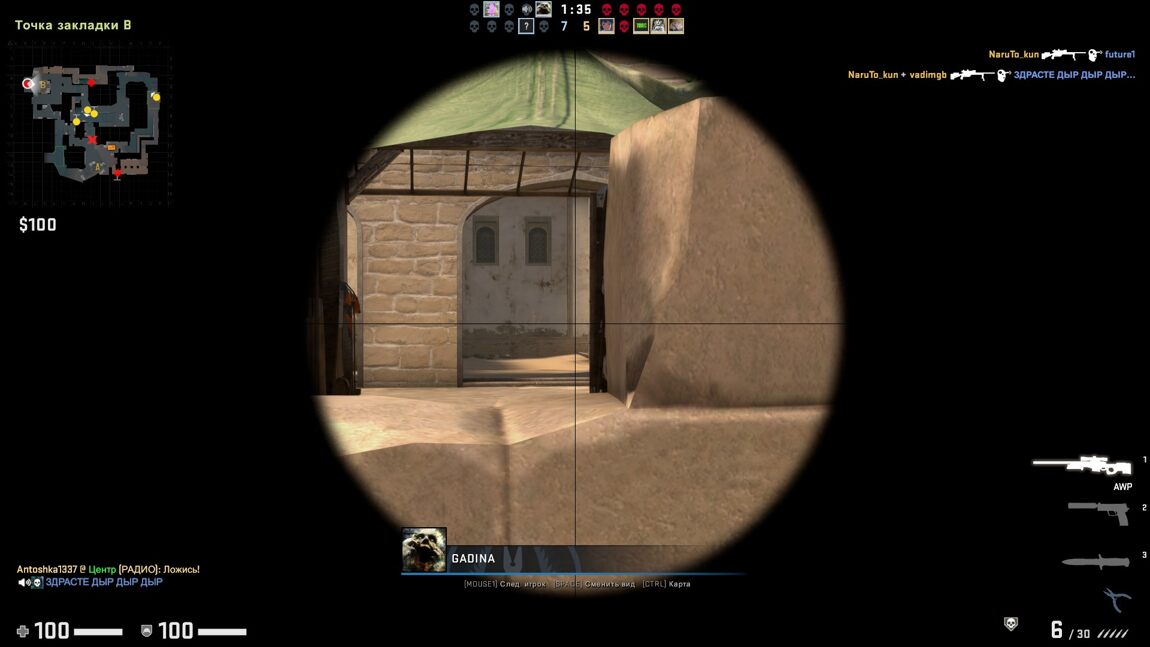
For greater convenience, some players set the monitor format 4:3 instead of 16:9 and stretch the picture over the entire screen - it makes a little thicker and models of the enemies, so that it becomes easier to hit them. On the other hand, this manipulation also increases the speed of moving the sight horizontally, so you still need to get used to the "running in width". And what is definitely useful at the beginning is setting radar so that you could see the whole map on it. Only experienced CS users are able to orient themselves by only one area.
How does pumping work?
Since we're talking about experience, you can't ignore the issue of pumping. In this, Global Offensive is both similar and dissimilar to other multiplayer free-to-play action games. On the one hand, there is a detailed progression system - with increasing levels, prizes and merit badges. On the other hand, neither rewards nor raises give any advantage in combat at all. All characters in any match are equally vulnerable, and the path to victory is paved by gamers' personal skills - not by bonuses acquired for a penny.
The game has two parallel ways of pumping - the acquisition of ranks and ranks. The first open with the accumulation of experience: the longer you fight in Counter-Strike, the higher your rank rises. There are 40 of these steps, from rookie to marshal, and capturing each brings some kind of reward, be it weapon coloring or graffiti to put on the walls during battles. Taking the third rank ("Private") gives you access to ranked battles. And if you reach the top level, you can reset your progress to zero for a special Service Medal - the color of that award depends on how many times you return to the beginning of the progression. So here and then you meet lieutenants and captains who have been in the marshals a couple of times. The second way of pumping, through the ranks, depends not on the time spent at the monitor, but on the skill of the user. It is this parameter, not the rank, is taken into account when selecting teams in the match.
The game has two parallel ways of pumping - the acquisition of ranks and ranks. The first open with the accumulation of experience: the longer you fight in Counter-Strike, the higher your rank rises. There are 40 of these steps, from rookie to marshal, and capturing each brings some kind of reward, be it weapon coloring or graffiti to put on the walls during battles. Taking the third rank ("Private") gives you access to ranked battles. And if you reach the top level, you can reset your progress to zero for a special Service Medal - the color of that award depends on how many times you return to the beginning of the progression. So here and then you meet lieutenants and captains who have been in the marshals a couple of times. The second way of pumping, through the ranks, depends not on the time spent at the monitor, but on the skill of the user. It is this parameter, not the rank, is taken into account when selecting teams in the match.
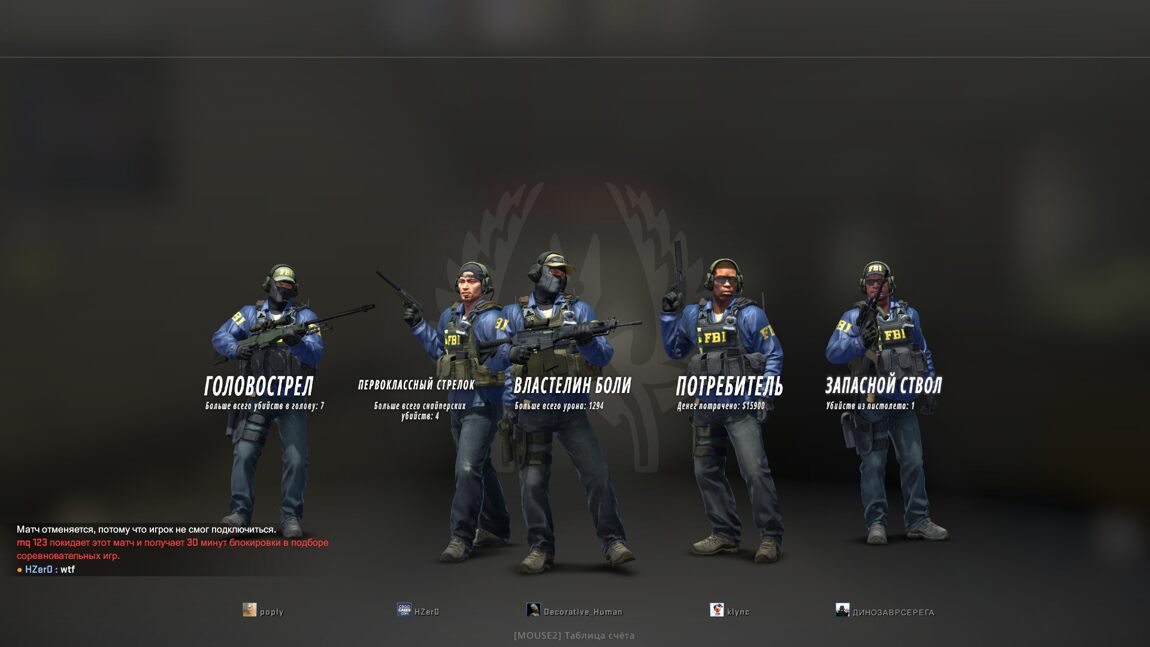
When you switch from normal mode to competitive mode, you get to calibration. This is a system that allows the game to assess your skill level. You have to score ten wins in ranked matches on the prime account to get your first rank - it is not always the lowest one for a newcomer. If you're a good teammate, an accurate marksman, and a solid grasp of tactics, you can earn one of the six silver ranks. Then there are the gold and advanced - a total of 18 badges, from Silver I to Global Elite, which immediately show what you know and which squad you'll get. There is only one way to change your rank for the better - you have to show an evolution of skill. However, reporting (complaining) about your behavior during firefights can complicate your progress, so skill evolution requires sporting behavior as well - no cheating or hooliganism.
Cases and skins in CS:GO
The game rewards success. But it doesn't do this by handing out boosts, artifacts, or any special guns that kill everyone around you, but purely by aesthetic means. Winning or opening a new level, you can get options for colors of weapons, drawings for graffiti and cases, that is, decorations of different kinds. Let's take a closer look at each of these items.
If the weapon itself in CS is associated with the game economy, the appearance of guns and knives, they also skins, are relevant to the real economy - where they use rubles and dollars. The amazing thing is that trade in wrappers for AWPs, AKs, and emotes has become truly global these days. Sale is engaged not only Steam, but also many other sites, and fans who want to get hold of rare colors, no end. And although we are talking about trivial decorations that do not give anything in the tactical sense, they have built a whole market. You can find out the price of the color as soon as you get it. Of course, you cannot get a five-digit price tag for half an hour on the "Office" because there is a real hunt for such rarities. What the mods do not go: download pirated programs, looking for discounts on dubious sites, go to special servers where no one fights, and all waiting for the end of the match and distribution of prizes. But those who care about the pleasure of the gameplay rarely pay attention to such tinsel.
If the weapon itself in CS is associated with the game economy, the appearance of guns and knives, they also skins, are relevant to the real economy - where they use rubles and dollars. The amazing thing is that trade in wrappers for AWPs, AKs, and emotes has become truly global these days. Sale is engaged not only Steam, but also many other sites, and fans who want to get hold of rare colors, no end. And although we are talking about trivial decorations that do not give anything in the tactical sense, they have built a whole market. You can find out the price of the color as soon as you get it. Of course, you cannot get a five-digit price tag for half an hour on the "Office" because there is a real hunt for such rarities. What the mods do not go: download pirated programs, looking for discounts on dubious sites, go to special servers where no one fights, and all waiting for the end of the match and distribution of prizes. But those who care about the pleasure of the gameplay rarely pay attention to such tinsel.
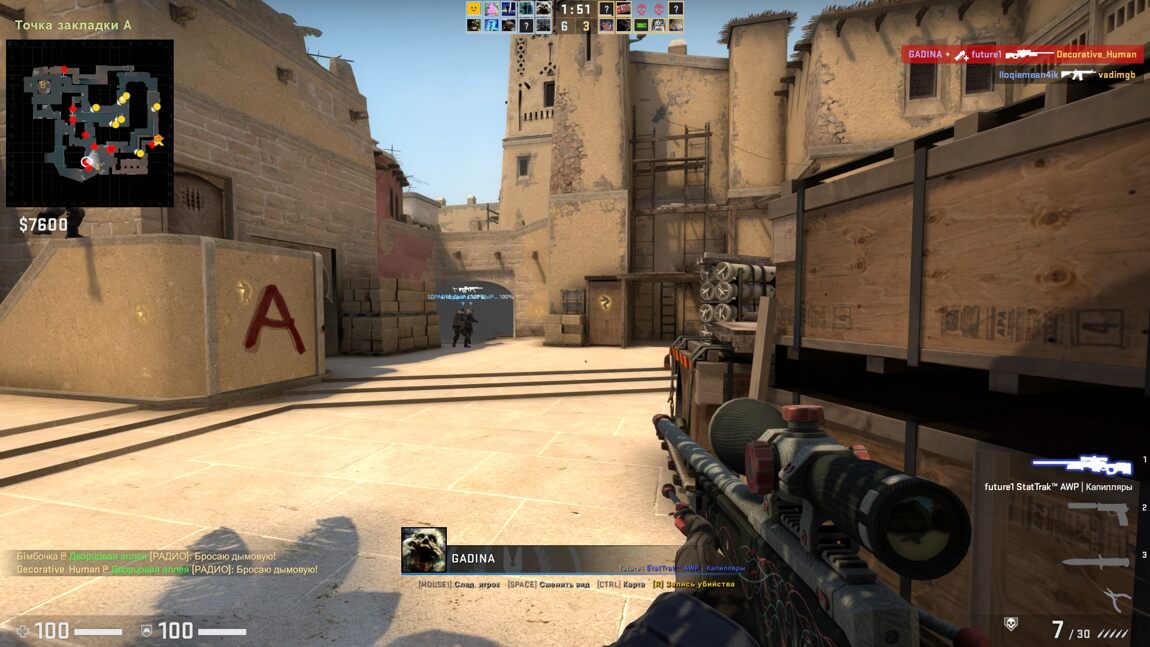
The exact same way to stand out is through graffiti. These are spray-on drawings on any hard surface in the environment. Again, such a picture does not give any advantage in strength, but it amuses the self-esteem of the "artist". You can get Graffiti for level up or buy it, just like a weapon skin. True, the commodity of spray curls is less marketable: the gun is looming before your eyes throughout the match, and the picture you put on the fence and ran on.
Case - a box with rewards, which can be obtained after the next promotion. But what exactly is hidden inside, just do not know. Surely known only that under the lid is not one but several items, including coloring books for weapons of varying degrees of rarity. To open such a box, you have to buy a key - for real money, of course. Some users even manage to make money on the boxes: they buy the cheapest one and wait until it ceases to fall out in the game, and then, taking advantage of growing demand for the vanished goods, sell it at a markup. However, the cases, just like the graffiti skins, have nothing to do with the fun of the shootings themselves.
Case - a box with rewards, which can be obtained after the next promotion. But what exactly is hidden inside, just do not know. Surely known only that under the lid is not one but several items, including coloring books for weapons of varying degrees of rarity. To open such a box, you have to buy a key - for real money, of course. Some users even manage to make money on the boxes: they buy the cheapest one and wait until it ceases to fall out in the game, and then, taking advantage of growing demand for the vanished goods, sell it at a markup. However, the cases, just like the graffiti skins, have nothing to do with the fun of the shootings themselves.
Conclusion
Counter-Strike: Global Offensive is a shooter that has not lost its relevance and fun since its release in 2012. It is a benchmark representative of the genre, with proven balance, pleasant shooting, and clear rules that encourage you not only to shoot accurately, but also to think about tactics. Also, the game is completely free - unlike most multiplayer action games, it is not possible to increase your chances of winning for money. You're only allowed to invest currency in jewelry, but that's not the main goal for someone who wants to enjoy the shootout. The only problem that may overshadow familiarity with CS these days is the abundance of cheaters in the regular mode, which at first falls to a beginner. Options to discharge the situation in this case are few. You can invite your friends from Steam to the matches or buy "Prime" and thus change the league.
20 August 2021